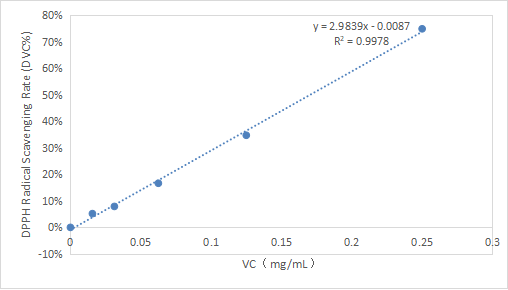| Product name | CheKine™ Micro DPPH Free Radical Scavenging Capacity Assay Kit |
| SampleType | Plant Tissues, Red Wine, and other Liquid samples |
| Alternative | DPPH |
| Kit components | • Extraction Buffer •Reagent I •Vitamin C (Positive Control) |
| Features & Benefits | The verified samples are complete in type and easy to operate. |
| Usage notes | • If not assayed immediately, samples can be stored at -80°C for one month.• It is recommended to perform several dilutions of your sample to ensure the readings are within the standard value range.• Fresh samples are necessary for good results. If don't perform the assay at the same time, it's better to complete the Sample Preparation step before storing the samples. |
| Storage instructions | Storage at 4°C and Keep from light immediately upon receipt. Kit has a storage time of 6 months from receipt. Refer to list of materials supplied for storage conditions of individual components. |
| Shipping | Gel pack with blue ice. |
| Precautions | The product listed herein is for research use only and is not intended for use in human or clinical diagnosis. Suggested applications of our products are not recommendations to use our products in violation of any patent or as a license. We cannot be responsible for patent infringements or other violations that may occur with the use of this product. |
| Background | DPPH radical is a very stable nitrogen-centered free radical and is one of the important indicators of sample antioxidant capacity.It is widely used in the research of antioxidant foods, health supplements, and pharmaceuticals. CheKine™ Micro DPPH Free Radical Scavenging Capacity Assay Kit provides a simple, convenient, and rapid method for measuring DPPH radical scavenging activity, suitable for plant tissues, red wine, and other liquid samples.The principle is based on the fact that DPPH radicals possess an unpaired electron, giving their ethanol solution a purple color with strong absorption at 515 nm. In the presence of antioxidants, DPPH radicals are scavenged, causing the solution color to fade and the absorbance at 515 nm to decrease. Within a certain range, the change in absorbance is proportional to the degree of radical scavenging. |
| Alternative | DPPH |

You must be logged in to post a review.
Reviews
There are no reviews yet.